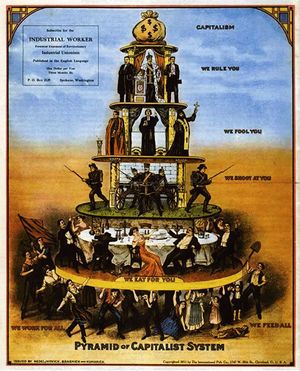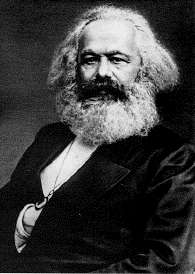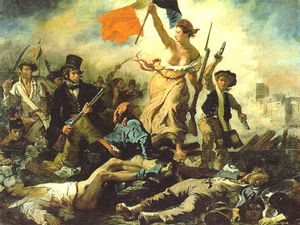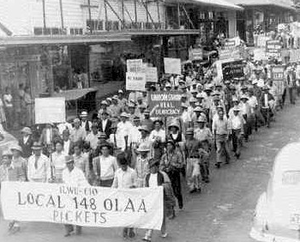Course:EDCP333/socialclass
Social Class: Background Knowledge
Defining Social Class
Social Classes - Generally, social class is used to describe the hierarchy that exists between members of society; positionally within this hierarchy is usually dependent upon one's economic standing. In the Western culture, one either belongs to the upper, middle or lower class. Social class is determined either by birth or achieved based on merit, skill and ability.
The upper class consists of a small portion of the population that possesses the majority of the wealth. The middle class contains a portion the population that does not control the majority of the wealth, but possess a certain amount of economic autonomy within society. Lastly, the lower class generally consists of a large portion of the population that does not have the ability to be economically autonomous due their lack of work or their inability to pursue luxuries that society presents them with. It must be noted that membership within these groups is not fixed. One may easily move between classes as a result of a number of significant factors.

Social Class Theories
Karl Marx

In Marxist theory, social class is primarily determined by one's relation to society's means of production. In modern capitalist society, Marx denotes two social classes: the proletariat, who own nothing and must sell their labour in order to survive, and the bourgeoisie, who own the means of production (factory or business) and profit by selling the surplus value created by the labour of the proletariat. Marx saw history as a progression of class struggles which would result in conflict and the overthrow of the prevailing social and economic structure and the creation of a new order. Marx predicted that under capitalism, the proletariat will become so exploited and alienated from their work that eventually they would rise up, overthrow the power of the bourgeoisie, seize the means of production and establish a socialist, classless society.
Max Weber
In Marxist theory, social class is primarily determined by one's relation to society's means of production. In modern capitalist society, Marx denotes two social classes: the proletariat, who own nothing and must sell their labour in order to survive, and the bourgeoisie, who own the means of production (factory or business) and profit by selling the surplus value created by the labour of the proletariat. Marx saw history as a progression of class struggles which would result in conflict and the overthrow of the prevailing social and economic structure and the creation of a new order. Marx predicted that under capitalism, the proletariat will become so exploited and alienated from their work that eventually they would rise up, overthrow the power of the bourgeoisie, seize the means of production and establish a socialist, classless society.
Mallot and Pruyn
Malott and Pruyn’s paper, Marxism and Critical Multicultural Social Studies focuses on the Marxist-oriented class struggle, paying close attention to the relationship between the means of production (labor – working class) and how it produces capitalism (capital – upper class). This paper proposes that social class is not a simple divide of labor and capital, but is perpetuated in the status quo and the dominant order of society. Teachers and the education system also continue to uphold the capitalist ideals by normalizing capitalist mechanisms, especially through “Traditional Social Studies Instruction”, which promotes obedience to authority while passing down dominant societal beliefs. Malott and Pruyn believe that educators should shift to “Critical Multicultural Social Studies” perspective by making the curriculum active through making connections with students. This approach emphasizes making connections with students through understanding their past histories, take action on what students and the community identify and define as issues of inequality and injustices, and allowing students to gain the tools to fight oppression and further the process of social justice in ways that are relevant in their own lives.
Anyon
In “Social Class and School Knowledge” Jean Anyon explores the different experiences that children have in schools according to their social class. The author visited a number of schools at varying social classes and performed interviews to determine what differences class status had on the type of education that was offered. Anyon found that “students of different social class backgrounds are still likely to be exposed to qualitatively different types of educational knowledge.” More significantly, this knowledge seemed to be tailored to replicate class structures by training students into the class into which they were born. Students at a working class school were primarily taught rote skills and procedures, while middle class schools emphasized comprehension. More affluent schools nurtured the individual interests of students and encouraged exploration, although the elite schools demanded that their students learn to understand and solve problems so as to serve as useful managers.
Critiquing the Curriculum
The issue with BC's curriculum is that the Integrated Resource Packages (IRP) serves the interests of the dominant political group. Paul Orlowski has noted that social class is invisible in our curriculum and this invisibility is created by curriculum develops to perpetuate the power structures that currently exist.
For instance, Orlowski highlights the following changes in the BC curriculum:
1949 - The rights of the worker disappear in order to counteract the rise of "Bolshevism and communist movements within North America at the time" (Orlowski, 32).
1956 - The curriculum presents the economy as robust, healthy and growing across the continent (Laxer, 1998) amidst a significant conflict between labour and capital, a conflict that Orlowski highlights as particular to British Columbia.
1968 - There is a removal of all of the learning objectives regarding trade and unions and labour legislations and no mention of implementation of the public health-care in Saskatchewan, the first of its kind in North America (Orlowski, 33).
1980 - The curriculum encourages students to understand "citizens as consumers, producers, taxpayers." In this way, the curriculum normalizes capitalism and the hierarchy inherent to our current capitalist model.
1988 - The Social Studies 9 curriculum addresses the Industrial Revolution and the working conditions of the time but fails to make connections to current working conditions.
1997 - Students are not encouraged to identify with their social class as the curriculum makers do not view social class as significant to the construction of identity.
In conclusion, the BC curriculum perpetuates the social class hierarchy that exists within society by not providing students with the tools to think critically about their own position within the hierarchy. Students see social class issues as problems from the past or in other countries. Therefore, the curriculum communicates the idea that the hierarchy is normal and fixed. It becomes the teacher's responsibility, then, to teach the content in the curriculum that addresses social class and connect it to social class issues today.
Teaching Social Class: How do we incorporate Social Class into our curriculum?
Social Studies 8
The Fall of Rome by: Cassie Lauang
Rationale:
This is the second lesson addressing the internal reasons for the fall of Rome. More specifically, this lesson will analyze the inadequacies of Roman politics and leadership and how these inadequacies lead to the decline of the civilization. Through a viewing of a parody of a well-known song and a class discussion regarding Roman politics, students will be able to evaluate the effect corrupt politics had on Rome and its citizens. Furthermore, they will be able to draw on their previous knowledge of themes from current popular literature and events in order to reflect on the results of corrupt leadership in society. Students will also develop their ability to analyze continuity and change as they compare and contrast politics and economics from the era of Roman civilization and now. A class discussion surrounding social class will guide students towards a critical analysis of social class in society today and allow them to re-examine their position in the hierarchy as well.
Objectives:
Describe the inadequacies of Roman leaders
Explore the continuity and change of social class through time
Hook:
Play Horrible Histories – Who’s Bad? music video
Class discussion: What does this video say about Roman political leadership? (This is a multiple task in that it allows students to think critically about a message contained within media rather than traditional text)
Body:
Lecture: Roman idea of democracy vs. the actuality of Roman government (Panem et circenses strategy), corrupt leaders, poor economic management i.e. overspending (gladiators) and inflation
Closure:
Class discussion: Introduce idea of social class in terms of Roman times
Discussion question at the end of the worksheet: “How do the powerful treat the powerless today?”
Social Studies 9
Below is a list of possible units where a teacher could deconstruct social class with their students:
French Revolution by: Tyler Klassen

Rationale: Through a lecture and debate regarding the Estates General, students will be able to understand the division of the French society before the Revolution. The social hierarchy will be presented in a manner that allows students to deconstruct the idea of social class and the results of a corrupt social class hierarchy. Students will be able to make a connection between the social class hierarchy that exists within Canada with the social class hierarchy in France. They will be able to evaluate the similarities and differences while also analyzing how tensions and conflicts between social classes are extremely significant factor in the makings of a revolution.
Objectives:
Students will know the main causes of the French Revolution
Students will understand how the Estates General operated
Hook:
Think pair share: “What would the Canadian government have to do in order for you to take action against it?”
Body (This is a multiple ability task in that it encourages interpersonal learning and group work as well as facilitating a critical analysis of the content)
1. Lecture notes “Reasons for the Revolution”
2. Estates General Simulation.
a. I will set the scene, taking on the role of Louis XVI. Clergy and Nobles will be given treats
b. Estates will vote by bloc
c. Encourage motions to: raise taxes on 1st and 2nd estate, reduce tithe and feudal obligation of peasants, change the way voting is done.
d. Simulation should get to point where 3rd estate decides to form ‘national assembly’
3. Lecture notes pt 2 “Estates General”
4. Youtube “French Revolution 3 of 4” http://www.youtube.com/watch?v=o8FMDHhth5A&feature=related
Closure
In order to set up idea of Bastille, teacher will briefly ask students to consider to be a peasant after the National Assembly is formed. Point out that material conditions have not improved)
Social Studies 10
Labour Songs Lesson Plan - This is lesson that gets students to analyze primary and secondary sources to understand the lifestyle of immigrants and working class citizens in Canada. The music really illustrates the working class concerns and struggles. (This is a multiple abilities task because it involves listening and analyzing music.)
Social Class in Victorian Society by Jessica Tan
Rationale: The Victorian Era is of great importance in this course because the attitudes, values, science and medicine innovations, and technological developments have provided a significant contribution to our present day Canadian society. The lesson will help link the events of the past to students’ personal lives and the society they live in today. In this lesson, there will be particular emphasis placed on the importance of social class at that time and its relationship to immigrants, women, and colonialism.
Objectives:
Apply critical thinking skills, such as comparing, summarizing, drawing conclusions, and defending a position by making inferences through primary document analysis.
Examine Canadian society during the Victorian Era in terms of daily lives, gender roles, and social class.
Understand how attitudes and events in the Victorian Era relate to contemporary Canadian society.
Hook:
Ask for 4 students to come up to the front of the class, 3 students will bring their chair. Play a quick game of musical chairs using Victorian era music.
Ask students whether they have played this game before and how they think this fits into the Victorian Era. Explain how the attitudes and innovations during this era are a precursor to the modern era – even though the time period may seem “out-of-date”, the Victorian Era shares many similarities (and differences) to the society we live in today.
Body:
1. Provide background knowledge of the Victorian Era - how the attitudes and beliefs of Queen Victoria were followed by Britain and her colonies. Relate 1837 rebellion to Victorian Era through increasingly apparent social class distinctions and ideas of colonialism.
- Define terms: assimilate, racial superiority, social class.
- Analyze quote: “To be born British was ‘to win the lottery of life’”. Focus on strict moral code, racial superiority, and obsession with social class – growth of materialism and the middle class.

2. Immigration and Social Class – Irish Catholics comprised a large percentage of immigrants in Canada. Why did they immigrate (discrimination in Ireland, rid of social class structure) and in what ways were they still discriminated in Canada (religion, Potato Famine stereotypes, social class)?
- What does the anti-Irish sentiment reveal to us about Victorian attitudes and beliefs?
3. Women’s Lives and Social Class – Discuss the lifestyle of Victorian women through primary document analysis. Show pictures of women in different social classes (poor working class, upper working class, middle class, and wealthy women) and get students to analyze the ways in which social class and gender roles/stereotypes are reflected through these primary documents.
4. Entertainment, Leisure, and Travel - Think, Pair, Share activity: Brainstorm ideas of what activities and events were popular during the Victorian Era. Emphasize social class and how it influences the availability and importance of particular activities.
Closure:
Summarize important issues that occurred in the Victorian Era and how social class became an important influence in the daily lives of those living in Canada. Recognize that social class is complex and intersects with other structures (i.e. immigrant, gender). Compare the similarities and differences between the Victorian society and our contemporary society.
Social Studies 11
Winnipeg General Strike
Winnipeg General Strike Lesson Plans - This is a great link for ideas pertaining to the Winnipeg General Strike in 1919. There are numerous activities and resources that can be modified to fit specific classes and used to teach about social class. For example, there is an activity related to different individual roles in the strike that can be adapted to analyzing social class.
External Links and Resources
Useful Activities
Star Power
Instructions and Method
Who is it for? & What are some of its features?
Organic Goodies
This simulation, published in Rethinking Our Classrooms, vol 1, is a more formalized version of that described by Mike Madsen in "Bubblegum and Surplus value." In it, students are told that the room is sealed, but everything they need can be obtained from a machine owned by the teacher. Students are divided into working and non working groups and are instructed that they must survive by making money and purchasing goods in order to earn a grade. The teacher's role is to act as a ruthless factory owner and try to is drive down the cost of labour and maximize personal profit by keeping the working class divided against each other. Students learn about class conflict, exploitation, labour movements and collective action. Rethinking Our Schools edition
Modified Monopoly (This is a multiple ability task because it allows students to incorporate artistic abilities with their understanding of the content.)
Modified Monopoly - This site provides an overview of the rules and purpose of a simulation titled "Experience Social Class Inequality" that is similar to the popular game board Monopoly. This game is used for cadets and faculty of the United States Military Academy at West Point, but it can definately be used in other schools and for all students. The simulation includes experiences of all social classes - upper, middle, working, and lower socioeconomic classes and illustrates the problem with the capitalist structure and social inequality. At the end of the game, teachers should provide a debrief and relate the feelings and frustrations of students to the larger social and institutional context.
Social Stratification Activities
Classroom Activities for Social Stratification - This site has some easy activities that teachers can implement in their classes to demonstrate social class divide.
Useful Websites
BCTF Antipoverty Social Justice Action Group - The British Columbia Teacher's Federation has created an antipoverty social justice action group and this website provides teachers and social justice activists with informative links and resources, such as novels, videos, and lesson plans. Here is a sample poster: Just An Average Classroom.
How Does Race and Class Affect Your Education? - This website is a great resource for those who are looking for background knowledge on the impacts of race and social class in education, but it also provides various in-depth resources.
Youth, Unions, and You - A Secondary Teacher’s Guide - This website provides tons of ready-to-use lesson plans regarding labor and union issues in British Columbia. It features lesson plans that span all grades and courses and these can be easily adapted for our students and lessons.
University of Akron: Teaching Social Class - This website from the University of Akron provides some interesting articles on social class and also provides some social class activities.
Useful Videos
'A Tale of Two Schools' - This short YouTube clip provides perspective on the unequal distribution of funding in the school system. It tells the story of two high schools: McLean High School in McLean, Virginia and Heritage High School in Baltimore, Maryland. Two high school students take Al Jazeera, an international news agency, around their high schools and the audience is exposed to both the students and the structure of the schools. It provides an insightful comparison between the two schools and students in terms of social class and also helps examine high schools in that frame of mind as well. It is useful to pair this video with the ideas presented in the Anyon article as well.
Freedom Writers - This film allows students to analyze media through a critical social class while also displaying facets of the Intersectionality theory. This film could be an effective introduction to the relationship between social class, racism, and sexism.

Useful Books
Howard's End - E.M Forster - This novel can be used to as a supplement to a social studies unit focusing on the Industrial Revolution and the tensions that exist not only between the upper class and lower classes but also within the middle class itself. It allows students to reflect on the issue of how members of each class depend on one another and the relationship between culture, intelligence and economic wealth.
The Hunger Games Trilogy - Suzanne Collins - This work of fiction illustrates social class in a very interesting way (through the Hunger Games) and this can be recommended to students to demonstrate how privilege and oppression works in this world of fiction, which can be easily related to our present society.
Useful Articles
E. Wayne Ross - Exploring Taylorism and Its Continued Influence on Work and Schooling.
This paper discusses the implications of Taylorism, the influential “scientific management” theory of the 20th century embedded within the workings of North American industry and education. Ross discusses the film Clockwork and how it can be incorporated into the secondary social studies classroom. Clockwork follows the ideas of Taylorism in the industry environment – increasing productivity, incorporation of technology, development of mass production and the assembly line, standardizing practices, and deskilling of worker. Ross makes an interesting connection of the mechanisms of Taylorism in industries and in our current education system. This film and the aspects of Taylorism can be easily included into the social studies curriculum, emphasizing how our current education system reflects factory processes and scientific management. This notion of Taylorism can be related to social class, as this theory of management can be seen as a way to protect the social status of particular people (i.e. managers) and certain skills.
E. Wayne Ross - Using Children’s Books to Explore Power, Tyranny, and Justice.
This paper focuses on using children’s books as a way to teach social studies and encourage critical thinking and recognize multiple perspectives for students of all ages. For example, teachers can get students to reproduce illustrations of a children’s book (in this case, Farmer Duck) and recognize the differences in the book’s illustrations and their own – focusing on who gets represented and how. Also, Gibson and Ross introduce another text about master/slave relationships – getting students to recognize how power and oppression play off each other and understanding human motivation and hierarchy. Analyzing children’s books can be used to teach students about many different social issues, and social class is one of them. There are a vast number of children’s stories and fairy tales involving social class available for social studies teachers to utilize in the classroom as historical documents to analyze.
Mike Messner. (1976). Bubblegum and Surplus Value. Critical Sociology, V6, No 51. pp 51-56
Mike Messner describes a useful simulation for teaching high school students about capitalist exploitation and class replication in “Bubblegum and Surplus Value.” The simulation appears to be the precursor to the “organic goodie” simulation published in “Rethinking Our Classroom” Vol 1 and involves students posing as the workers and unemployed people of a society in which the means of production is privately owned and operated for the benefit of its owner, the classroom teacher. The aim of the simulation is to have the students understand the way the surplus value they are creating is being exploited and recognize their collective interest to unionize against their employer. Messner connects this to Marxist theory and capitalist imperialism, and also includes elements such as gender division, immigration and the suppression of democratic dissent.
Group Members
Tyler Klassen, Cassie Lauang, Jessica Tan